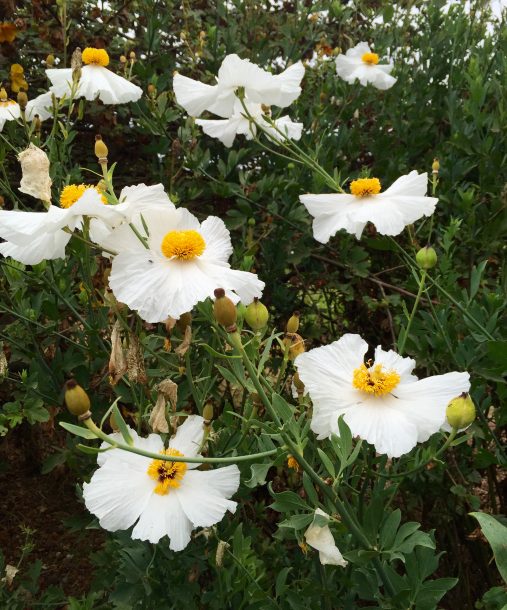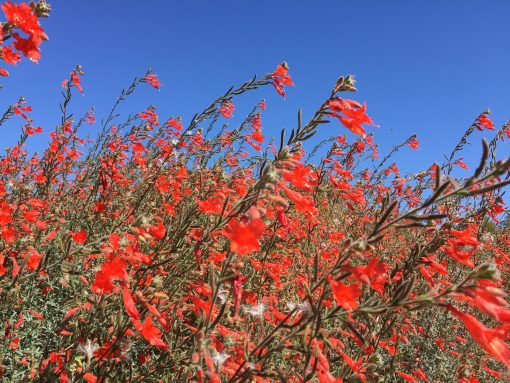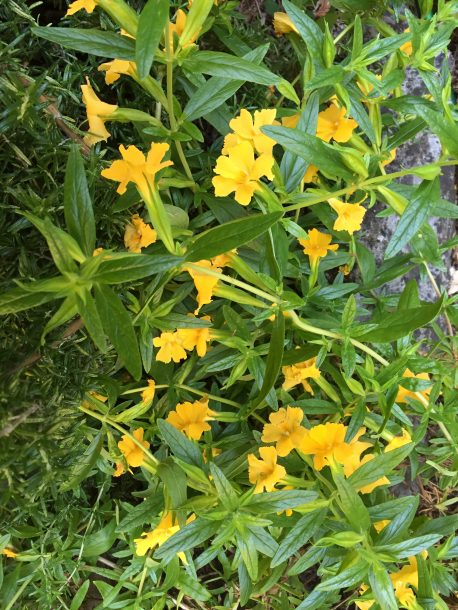
is poisonous to humans and animals.
Looks like we’re in for a hot summer. Already we’ve had scorching temperatures and since it’s only the beginning of July, you can bet there will be more hot spells. How can you help your plants survive a heat wave? Are there some plants better adapted to handle hot temperatures?
Photosynthesis is one of the most remarkable biochemical processes on earth and allows plants to use sunlight to make food from water and carbon dioxide. But at temperatures about 104 degrees the enzymes that carry out photosynthesis lose their shape and functionality. A garden that provides optimum light and water but gets too hot will be less vigorous. Tomatoes, for example, will drop blossoms and not set fruit if temperatures are over 90 degrees. Plants that endure high heat can be stunted, weakened and attract pests and diseases even if water is available.
Understanding how plants respond to heat stress is important for developing crops that can withstand rising temperatures and more frequent heat waves under climate change. Much research is being done to counter drastically reduced crop harvests from increased temperatures.

Plants do have natural systems that respond to heat problems. Some plants are better at this than others. Plants can cool themselves by pumping water out through the leaves for a kind of swamp cooler effect. They can also make “heat-shock” proteins which reduces problems from over heating. All these strategies take resources away from a plants other needs like growth, flowering and fruiting.
Plants respond to heat stress by activating hormones which act as chemical messengers. Brassinosteroids are one of these hormones. They have growth promoting properties as well as the ability to increase the heat stress resistance of plants. Because it is a natural product it is approved for organic farming. Research continues to create varieties that are more resistance to heat stress and also provide more stable harvests.
It’s no surprise that many California natives are adapted to high temperatures. Bees Bliss Sage, a low groundcover that can reach 6-8 ft wide is a plant that can It has an extended bloom time from mid-spring to early fall with whorls of lavender-blue flower spikes. Bees, butterflies and hummingbirds all find it attractive.
Another plant that can handle high temps is salvia clevelandii. Their blooming cycle of electric blue-purple flowers will last through the summer. This salvia survives without any supplemental irrigation but if you give it an occasional deep watering and wash off the foliage every so often it’s much happier. All the salvias are good performers in the heat. Just be sure to keep them groomed of dead leaves and branches to keep your garden fire safe.

Who doesn’t like color in their garden? Mimulus or Sticky Monkey Flower blooms are showy and the hummingbirds love them. The Jelly Bean series has added bright pink colors in addition to white, orange, red and yellow but the traditional aurantiacus types are the most tolerant of drought.
Other California native plants that can handle the heat with little water include matilija poppy, eriogonum, manzanita, artemisia, California milkweed, California fuchsia, ceanothus, mountain mahogany, bush poppy, bush lupine, native penstemon, monardella, mahonia nevinii , fremontodendron and holly-leafed cherry.
Non-native but well-adapted plants that are known to be more tolerant of heat include butterfly bush, germander, rosemary, smoke tree, rudbeckia, coreopsis, lantana, plumbago, gaillardia, lilac, sedums, oregano and verbena.
These plants can be the rock stars of your garden. Some natives that are able to survive with no irrigation after 2 years may look more attractive with a few deep waterings per summer. And don’t forget the wood chip mulch (not bark chips) to encourage the soil microbes and keep the soil cool.
